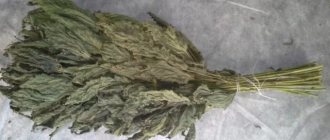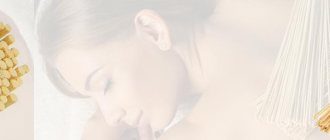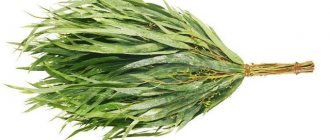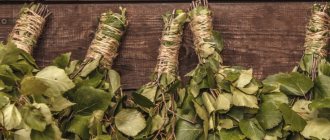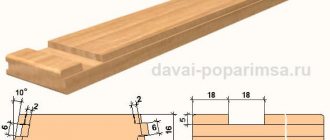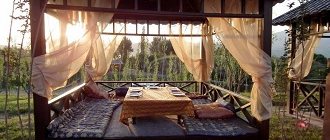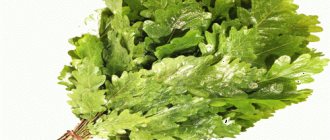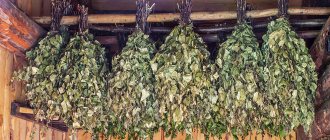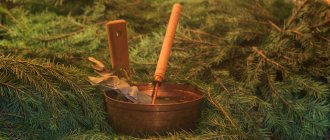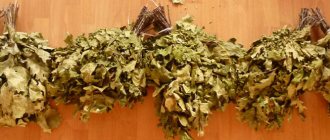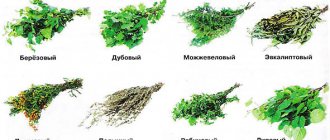How to knit and steam bath brooms correctly - learn to do everything wisely
Going to a Russian bathhouse and not taking a broom with you means deliberately depriving yourself of a kind of therapeutic massage. The biting touches of a broom increase blood circulation, promote full opening of skin pores, and cleanse the body of toxins. Moreover, phytoncides evaporating from leaves and branches destroy pathogenic bacteria, which means that a sick person, having taken a steam bath, has every chance of recovery. The healing power of a “broom” massage in a Russian steam room is enormous! And in order to try it on yourself, the first thing you will have to do is acquire its main attribute - a broom. Of course, you can buy it in a store, but real bath attendants prefer to knit bath brooms with their own hands. This means that you too will learn this now.
Which broom is best for a bath?
First you need to decide which tree you will cut the branches from for the broom. In other words, which broom is better for a bath - oak, birch or even juniper? All of them are good, but you should still choose based on what health effect you want to get.
For example, oak bath brooms are good for those with oily skin, as they help cleanse it well and relieve inflammation. Birch brooms eliminate muscle and joint pain, juniper brooms have bactericidal properties, therefore they are useful for those suffering from colds.
Preparation of branches for a broom and binding
Now, after you have decided on the material for making your broom, it’s time to go get some branches. They should be cut from the tree in dry weather, preferably in the morning, after the dew has dried. As a rule, this is done on Trinity Day, that is, from the end of May to the end of June.
The branches chosen are flexible, not dry, or with branches - this will make the broom fluffier.
Having brought home an armful of cut branches, start knitting. For this:
1. Sort through the branches and prepare them
First, review all the branches again - perhaps you missed some "marriage". Put everything that is excessively woody or “liquid” aside, since such material is not suitable for a broom. Leave only densely leafy branches of approximately the same length, within 40-70 cm (brooms of this length are considered the most convenient).
On the remaining branches below, tear off all the leaves so that there is a bare trunk for the broom handle. The optimal handle length is different for each person - on average, two palm widths. Naturally, when picking off leaves, focus on your palm.
2. Bundle the branches
The branches in the broom also need to be placed correctly; both the shape of the product and the ease of further use will depend on this. Large and thick branches are placed in the center of the bunch, and thinner ones are placed around, forming a “fan”. How many branches do you need to put in a broom? Here you should focus on your own tastes regarding the thickness of this bath attribute, as well as on the size of the handle. Its diameter should be approximately 3-5 cm.
3. Tie the branches
When knitting brooms for a bath, try not to use synthetic and potentially hazardous materials. It would seem very convenient to tie a broom handle with metal wire. However, this is strictly forbidden: at high temperatures in the steam room, the metal will become hot and will mercilessly burn your hands. Therefore, for tying branches, natural dense twine, hemp rope or a medical bandage are usually used.
The branches collected in a bundle are tied twice: the first knot is made at the upper border of the butt, the second - not reaching 3-4 cm from the lower edge.
Now we can confidently say that you are guaranteed a bathhouse with a broom. The prepared broom can be used immediately, fresh, or dried. For example, hanging them in the attic on a rope in pairs or laying them in a haystack.
How to steam a bath broom correctly?
Brooms can be steamed in different ways, usually depending on the degree to which they have been dried.
A broom made from fresh branches does not need steaming. As a rule, it is enough to keep it in warm water for a couple of minutes so that it reaches the desired condition. You cannot dip such a broom into boiling water, as the leaves will quickly cook, stick to the skin and burn it.
Unlike fresh ones, dried brooms must be steamed before use. Some of the many ways this can be done are demonstrated in the following video:
Or you can do this: a well-dried broom is first dipped in warm water, and then in hot water for 10-15 minutes. In order to steam the broom better, you can cover the basin with water with a lid. Here it is important not to overdo it and not to dip the broom in boiling water, otherwise all the leaves from it will fly off after a couple of visits to the steam room.
A dry broom is dealt with differently. To begin with, it is immersed in hot water for a minute, and then placed on the hot stones of the heater. At the same time, a healing herbal aroma will spread throughout the steam room, and the broom will become soft. If after this procedure it still remains dry, repeat the cycle of actions again.
A very simple method can be used if you have time before going to the bathhouse - at least half a day. First, the dry broom is doused with cold water (this is easy to do just under a tap or in the shower), then with hot water, then dipped in warm water and again in hot water. Next, the broom is hidden in a plastic bag, where it will be saturated with moisture until you go to the bathhouse.
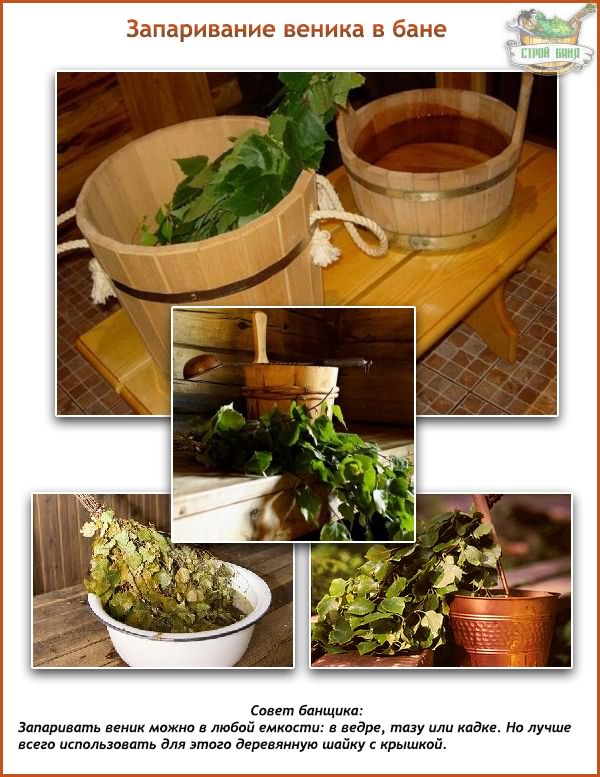
A properly prepared and steamed broom is not a disposable “massager”. As a rule, one broom is enough for 3-4 visits to the bathhouse.
stroy-banya.com>
How to properly knit brooms for a Russian bath?
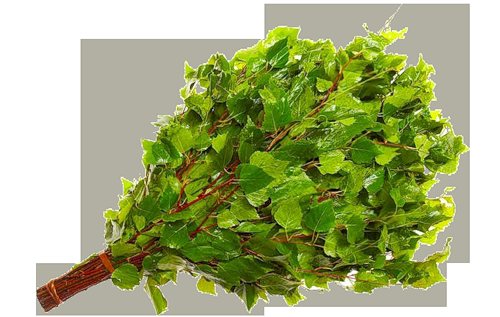
How to knit brooms yourself? It’s not for nothing that they say: “In a bathhouse, the broom is master.”
What a bath without a good broom! Not all those who like to take a steam bath prepare brooms for their bathhouse with their own hands:
- once
- don't know where
- don't know how to knit
Many people buy ready-made brooms, since now they can be purchased everywhere: at the market, in the bathhouse, in the supermarket. Not all purchased brooms are of high quality; there are also those that contain a couple of branches, but the price is prohibitive. So isn’t it better to learn how to prepare brooms yourself and do it the way you like?
How to knit brooms correctly so that they are just for you?! Yours - in size and quality?!
On Trinity Day, which occurs on the 49th day after Easter, birch branches must be cut. It’s not as difficult as it seems: you take a pruning shear and chick-chick everything: from large branches you can always make medium and small ones, and from small branches you will get cute little brooms for children.
When you have collected a large armful, then you can calmly sit down and start sorting and preparing the chopped branches:
- shorten
- trim off excess
- cut side branches from large branches
- arrange all the material according to size: longer branches in one pile, shorter ones in the other
Not everyone can knit good brooms right away; you need to get better at it in practice. You need to not just take a bunch and tie it with a rope, but fold each branch one by one, choosing each its own individual place in the broom depending on its shape and most importantly: you need to align the branches along the top so that not a single top sticks out higher than all of them. If it is out of size, then either correct it by lowering it down or put it aside for the next broom. At the end of the process, the lower ends of the branches in the broom handle will need to be cut off evenly (chopped off with an ax). The broom handle needs to be tied with a string in two places: this will be stronger and more reliable.
The broom should look like this:
- smooth
- fluffy
- easy
- neat
- cute
It is better to select the number of branches in a broom depending on the desired thickness of the broom handle. If a man knits for himself and his friends, then the broom handle usually turns out to be thick and powerful and, accordingly, the broom is large and heavy:
- a man has a large hand and it is more convenient for him to hold a thicker broom in his hand
- men love big and massive objects
- with a large broom it is more convenient to “catch up” with a large volume of steam at once
This broom is not suitable for women:
- the hand is much smaller than a man’s and it’s uncomfortable to hold a thick broom in your hand
- There is less physical strength and therefore it is impossible for a woman to “wave” a massive broom: her hand gets tired quickly. You have to take such a broom with both hands and “chop” it from your shoulder like an ax.
It is necessary to take into account that any broom becomes heavier when it becomes wet. If it was massive when dry, it will become twice as heavy in the steam room.
And it’s more convenient to work with two light brooms at once in a steam room: more efficient. Therefore, it is best to knit brooms of medium universal sizes and light in weight.
Also, the broom must be tied so that it does not fall apart in the bathhouse: tie the handle correctly and tightly so that after each entry into the steam room you do not have to straighten the branches and do not re-bandage the handle.
And one more secret: when drying, it is desirable that the brooms take on a flatter shape. To do this, first place the brooms on some flat surface and dry for a while, turning them over from one side to the other. And then hang it in a dark and well-ventilated area. In the attic, every twig, every leaf in the broom will gradually and moderately dry out, without losing its shape and pristine green color.
How to knit brooms correctly, watch this video:
When to knit brooms for a bath: collection of raw materials and beneficial properties of plants
A broom is the basis of a Russian bath; of course, it can be purchased in a specialized store, but it is much better to prepare it yourself. Then there will be complete confidence that the raw materials are collected according to all the rules and contain the entire complex of useful substances. Knitting brooms for a bath can be combined with a trip to nature.
The essential oils contained in the broom have a beneficial effect on the condition of the skin - nourish, rejuvenate, and make it more elastic. Using a broom is useful for joints and for treating the respiratory tract.
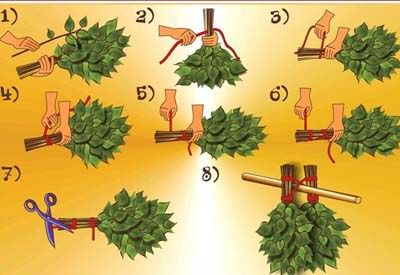
Knitting a birch broom
Harvesting must be carried out within a certain period of time, otherwise it will not be possible to achieve the desired effect. Many types of trees and medicinal herbs are suitable for the broom. The main requirement is that the plant grows in an ecologically clean area, away from roads and populated areas.
Which plants are suitable for knitting brooms: the period of collecting raw materials
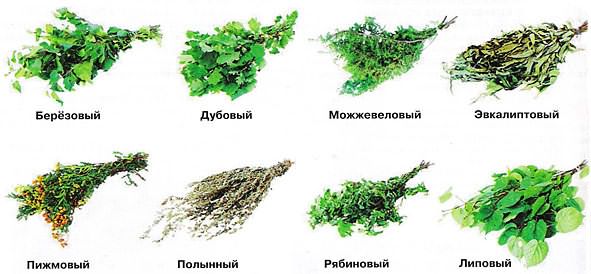
Brooms for all occasions
One of the most popular plants in Russia is birch, but it is not the only one suitable for knitting brooms.
There are traditional types:
- Oak;
- Linden;
- Juniper;
- Eucalyptus;
- Tansy;
- Artemisia;
- Rowan;
- Nettles;
- Spruce
Each of them is endowed with various beneficial properties aimed at restoring body functions. The quality of the future broom and its durability directly depend on where and when the raw materials were collected.
Birch: collection time and beneficial properties
Birch - a “storehouse” of health
This plant is rightfully considered the best participant in bath procedures. It has a gentle effect on the body. The collection of raw materials begins in mid-June and continues until August 2. Young flexible branches of weeping birch and curly birch, growing on the banks of reservoirs, are best suited.
With your own hands, cut only side shoots about 50-60 cm long, without touching the tops of the trees. Harvesting at the beginning of summer is quite justified - by this time the foliage has already absorbed sufficient nutrients and is filled with essential oils.
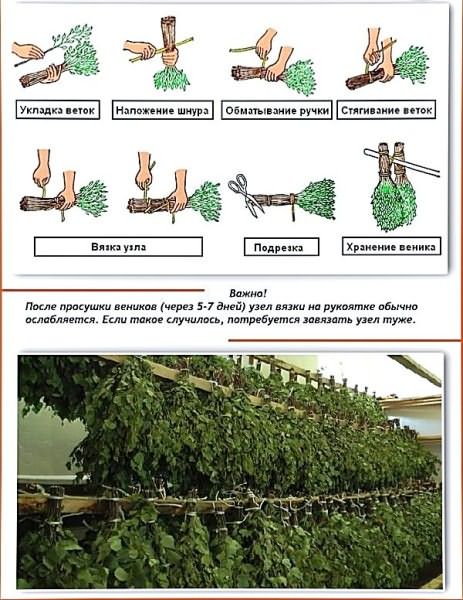
How to knit birch bath brooms correctly
What are the requirements for birch branches and leaves:
- The age of the tree should not exceed 2-3 years;
- The outer side of the leaf is tender and smooth; the rough ones will make a rough and hard broom;
- The leaf size is small to medium;
- There should be no knots on the branches.
Only a dry day is suitable for collection; if it rained the day before, you will have to wait a few days.
What effect do the substances contained in birch leaves have on the body:
- Relieves aches in muscles and joints;
- Eliminates skin irritation, cleansing it well;
- Wounds heal several times faster;
- It has a positive effect on the respiratory tract - very useful for experienced smokers and asthmatics.
Note! The infusion left after steaming the broom is very beneficial for the scalp - it relieves itching and eliminates dandruff.
Oak broom: when to collect
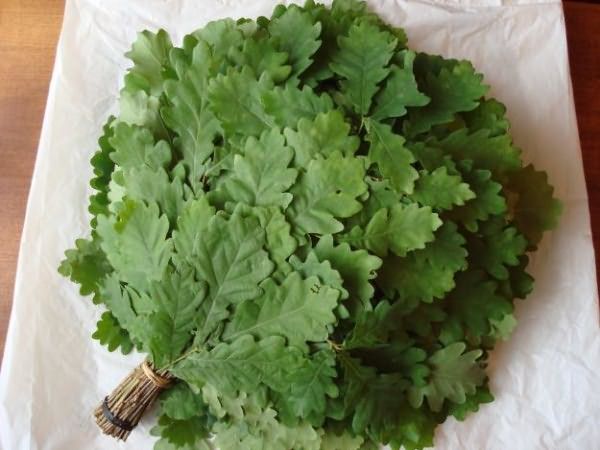
Photo of a fresh oak broom
The second most popular tree after birch is oak. It is harvested in July-September; “winter” is most suitable - it does not shed its leaves and, accordingly, is more durable. If you are lucky enough to find a tree growing in a dense darkened forest next to large burdocks, then the branches from it are also suitable for collecting - the leaves from them do not fall off for a long time.
The most popular species can be called pedunculate oak - this is the most common, it grows throughout Russia. Young trees 3-4 meters high are suitable; small plants should not be touched - they may die. Plants should be given rest and brooms should be harvested from them no more than once a year.
The earlier the broom is prepared, the more tender the foliage, but it will also be less durable. They cook them until the first frost, then they can no longer be cooked. But the optimal time ends in September, then the quality of raw materials drops.
To know how to properly knit oak bath brooms, you need to understand their beneficial properties:
- Unlike birch, oak does not cause profuse sweating, therefore it is more suitable for those with oily skin;
- The skin becomes denser, tannins and essential oils cleanse, have bactericidal properties and impart dullness and elasticity, preventing aging;
- People prone to high blood pressure and heart disease can steam with such a broom - it calms the nervous system and helps reduce blood pressure;
- Has a strong anti-inflammatory effect.
Brooms are knitted in two ways: with a shovel and with a ball. This does not affect the properties in any way and depends on personal preference.
Features of preparing brooms from other raw materials
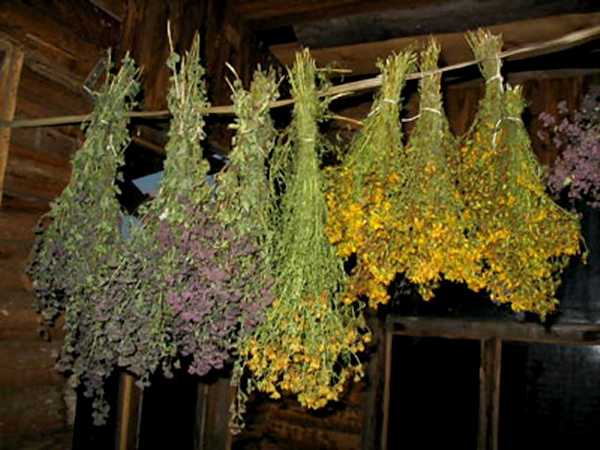
Medicinal herbs for baths
Not only ordinary trees and shrubs can serve as raw materials for bath brooms. For them, medicinal herbs are used, which are not necessarily used as decoctions or tinctures. One of the treatment methods is to “drive” them into the skin.
To do this, herbs are collected and tied into bundles by type or prefabricated brooms are made. To select the right herbs, you need to know when to collect them and how to knit brooms for a bath, combining different raw materials. Each medicinal plant has its own collection period. It is at this time that it accumulates the maximum amount of useful substances.
For brooms, flowers and leaves are prepared on a long stem so that they can be tied conveniently. They are collected by hand; the plants must have no signs of wilting and grow away from roads.
Suitable for use in a steam room:
- Tansy - collected at the end of summer, dried in the shade. Brooms made from it help cure skin diseases and joint pain;
- Wormwood - brooms can be knitted all summer, but the best time for collecting is June. It relieves irritability and improves sleep;
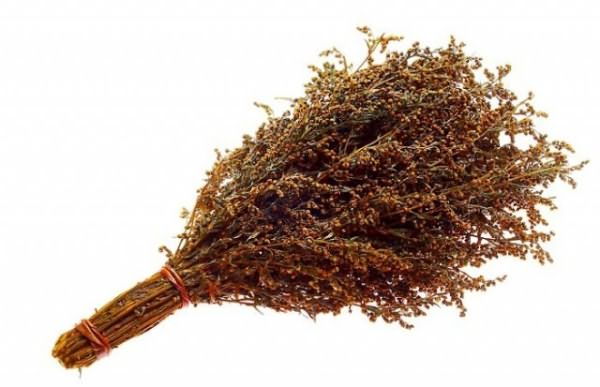
How to knit a bathhouse broom from wormwood - just like traditional types
- Nettle – young plants are harvested in May. At this time, it is not particularly hot and can be used even fresh. The plant has a tonic effect;
- Yarrow - collected during flowering, used in combination with other herbs. Relieves skin irritation;
- Chamomile – it is harvested in June. Bunches of the plant are tied into bath brooms made of birch or linden. Soothes and disinfects wounds.
Note! Medicinal herbs as bath brooms should be used only after consultation with a doctor, and if there are no contraindications.
If the time of collecting medicinal herbs and other raw materials for brooms coincides, then they can be dried together. You need to know how to properly tie a broom for a bath if it contains several types of plants. Herbs are usually placed in the middle and hidden by the main branches.
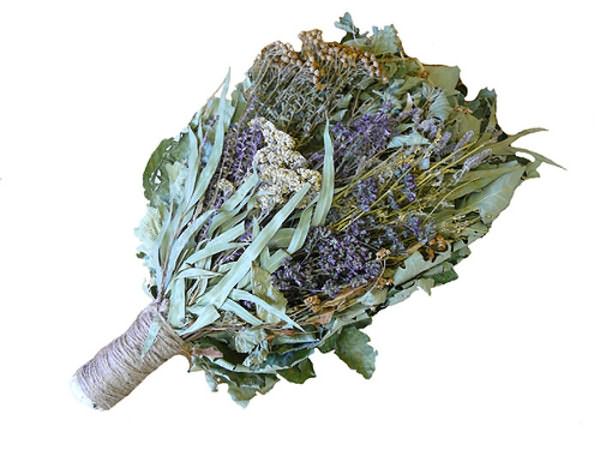
Combination of various medicinal herbs
Before harvesting and knitting brooms from different plants, you need to familiarize yourself with their beneficial properties, which are described in the instructions for use. Medicinal raw materials are dried and stored for no more than one year.
When knitting brooms from pine needles and eucalyptus
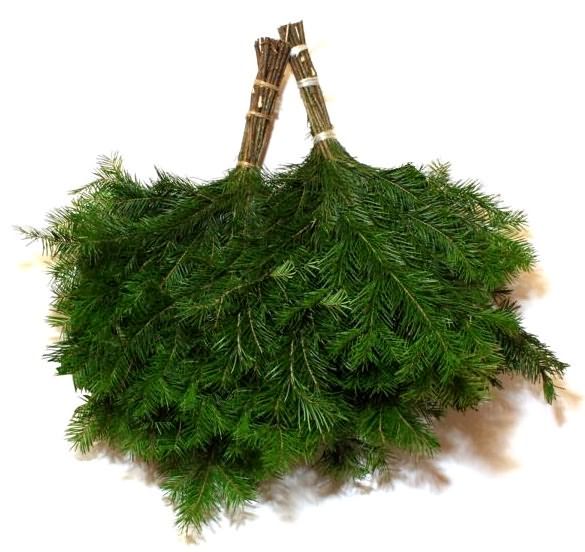
Broom from young pine needles
It makes no sense to harvest branches of coniferous trees for future use, because when the needles dry out, they fall off. Therefore, real experts and lovers of steaming cut off the branches immediately before going to the bathhouse. As a result, you can use fresh brooms throughout the year. The exception is juniper, but it is not stored for long.
How to knit bath brooms from coniferous plants so that excess resin does not interfere with steaming? They must be arranged in a certain sequence: thick branches are laid inside, and the outside is lined with flexible and thin ones. It is useful to add branches of other plants and wrap them with a rope; they will cover the handle and the resin will not get dirty.
Branches of some trees that do not grow in central Russia are harvested until the end of November. For example, eucalyptus, whose leaves are just gaining full strength by this time. Dry the raw materials at a temperature not exceeding 35 degrees, in the shade. For greater safety, they are packaged in paper or cloth bags.
Eucalyptus brooms help in the treatment of skin and colds and stimulate the immune system. Since its branches are very thin and flexible, it is advisable to combine it with birch. The price for them depends on the size and length of the branches.
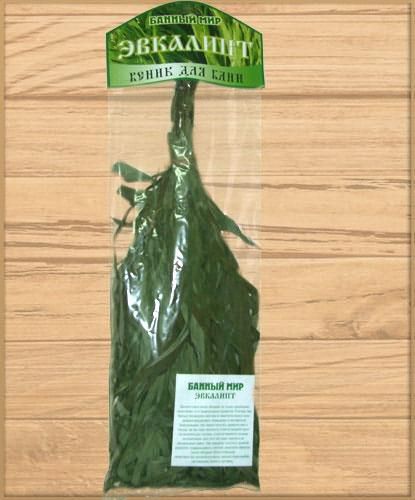
Packaged eucalyptus in a specialty store
Conclusion
Bath brooms are used for medicinal and cosmetic purposes. The time for harvesting raw materials for bath brooms varies depending on the plant, but to a greater extent it occurs in May-September, with the exception of needles. It is during this period that the accumulation of useful substances takes place.
In order for bath procedures to bring joy, it is important to knit brooms correctly and store them. The video in this article will tell you about when and how to collect herbs and tree branches.
9ban.ru>
Do-it-yourself oak broom for a bath
An oak bundle of branches brings to man the strength that nature gave to mighty and powerful trees, growing through generations of people, hiding the secrets of centuries in their rings. He will bring pleasure from the bath, the master knows how to make a broom for a bath from oak, at what time to cut off the branches, how to protect the tree so that strong young shoots continue to grow, from which the master will knit another gift for those who like to take a steam bath.
Excellent fagoliki are obtained from the branches of old trees, hardened by winds and frosts. Knitters take care of young trees, less than 5 years old. Branches are taken at two times - during the wild flowering of meadow herbs, and during the first winter frosts, when the oaks have not yet lost their leaves. Winter oak is considered the most useful for a person; in a steam room, it gains strength and resistance to any troubles.
Interesting! High-quality brooms are knitted from different types of oak: winter, English, alpine. These are the main types of oak growing in Russia. Dense forests contain three-hundred-year-old trees; the branches of such an oak will bring the greatest strength and health.
Preparing brooms for a bath: when to collect and how to knit
There is nothing complicated in preparing brooms for a bath, but, as in every business, there are some nuances: you need to know when it is better to knit brooms for a bath, which branches to choose, how long they should be, how to preserve brooms for the whole year without losing quality .
When to knit brooms for a bath
Our ancestors prepared raw materials for bath brooms in the first half of June - on Trinity Day after Green Christmastide. If you are far from church calendars and rituals, collect branches in early June, when the foliage has already grown and become stronger, but has not yet become faded and withered.
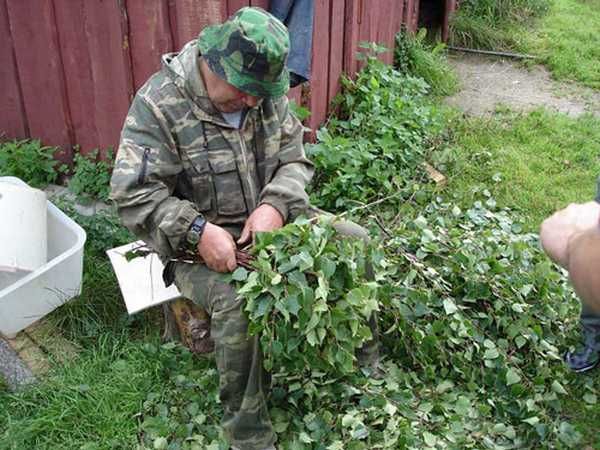
You can knit brooms for a bath yourself
For church holidays or calendar dates, you can only focus on regions: our country is large. In some places it’s almost summer on Trinity Sunday, and in others the leaves have barely sprung. So it’s better to focus on the condition of the foliage.
When are birch brooms harvested?
Not much time is allotted for harvesting birch brooms: a week at most. You need to have time to prepare birch branches when the leaf has already turned green, and not light green, but before the earrings bloom. If time is missed, the foliage becomes very hard and falls off greatly in the bathhouse. So the harvesting period for birch brooms is very short.
But time is not the only criterion. When choosing branches for a birch broom, you need to be guided by the appearance of the leaf. It should have a deep green color, the plate should be smooth. There should be no aphids or other pests or diseases. But, most importantly, there should be no earrings on the branches. And for greater effect, you need to cut birch branches with a broom during the specified period, but after a rain. Only the birch must already be dry, otherwise when steaming the leaf will darken and curl.
More advice from the older generation: cut a broom when the leaf on the birch tree is no larger than an old five-kopeck coin, and it should feel slightly sticky to the touch.
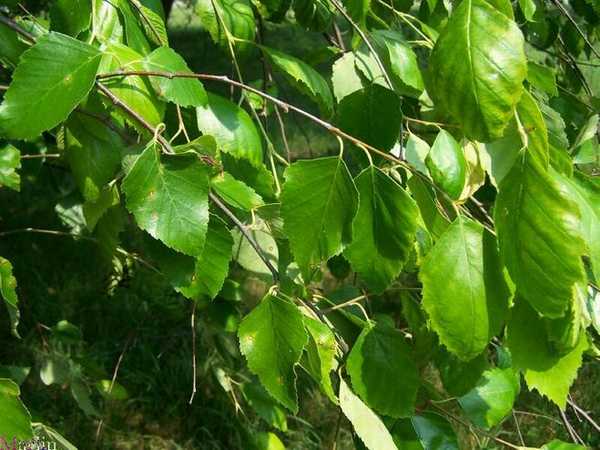
For birch brooms, choose young trees growing in the sun on a hillock or near a pond
But with sticky leaves you get a “soapy broom”. It has an excellent effect on the skin: it becomes silky and soft. But at the same time, leave the steam room with your skin covered in mucus. Not everyone likes this feeling. So here you have to choose: either more comfortable sensations with more “mature” foliage or elastic skin.
Birch brooms harvested in May smell differently than summer ones: they add a smell very similar to the smell of propolis. At this time, there are light stripes on the skin of the twigs, which release this aroma. Such stripes are not found on all branches; they need to be selected separately. When you run your hand along such a branch, you feel the tubercles - these are the same resinous, odorous secretions. If anyone hasn't tried it, try it. Very pleasant sensations, although the sheet is sticky at this time.
Some bathhouse lovers especially appreciate birch brooms that grew near water - a river or lake (but not in a swamp). Such plants have long, elastic and flexible branches. Twigs, growing roots or stumps of birch trees are good. They are flexible, elastic and tender.
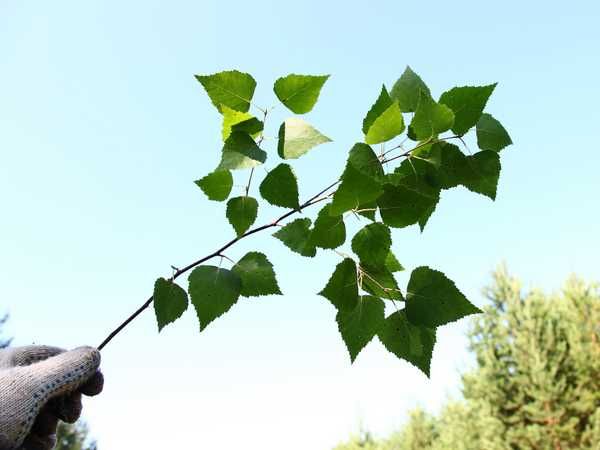
Branches for a broom should have two or three branches
On trees, the lower climbing shoots are considered the best. They are cut for a broom. It is better not to cut single young ones without side branches, even despite the large, beautiful and dense leaf: it turns out to be a whip. And this is not at all what is required from a bath broom.
If you don’t need to cut more than two or three pieces of a young tree, you can harm the plant. Know your limits - take care of nature!
Old people who love baths say that even in a birch grove you can’t take branches for a broom from every tree. But only from those whose birch bark on the trunk seems to shine a little. Moreover, the spots on the birch bark are not gray, but rather brownish in color. There are not very many such trees, but they exist. Try to find at least a few and stack the branches separately. Then evaluate the difference and next time you won’t regret it.
When preparing brooms, birch foliage should be dense and smooth. Some people recommend trying a birch leaf with your tongue. If it is rough, the branch is not suitable, if it is smooth and velvety, it is an excellent raw material.
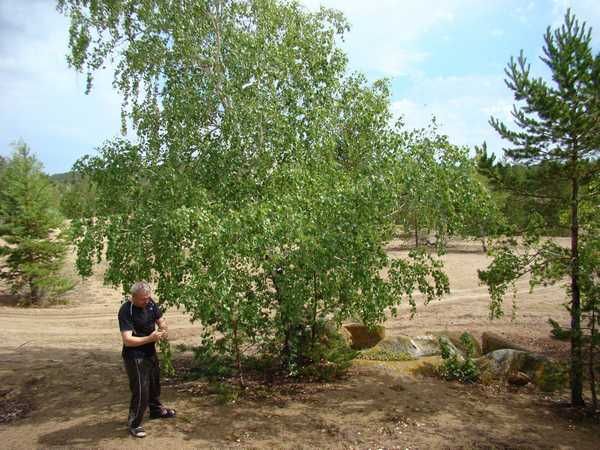
Separately growing young trees are an excellent choice
You can navigate by the stem of a young birch leaf. If it has already turned reddish, you can cut it, but if it is green, it’s too early.
The video shows how to choose birch branches and correctly knit brooms from them.
We prepare oak brooms
The harvesting period for oak brooms is longer: starting from the end of June, and some are harvested in August and early September. Depends on the year and region. But even in the same region, it differs greatly from year to year. In some areas you have to hurry: later the foliage is affected by diseases and becomes lethargic or spotted. But sometimes, after disease damage in August-September, the foliage on the oak tree grows back. Then you can also get excellent brooms.
When harvesting an oak broom in the summer, pay attention to the condition of the leaf: it should be an even, dense green color, without spots. The main rule: there should not be an acorn yet. As when harvesting birch, branched shoots with large leaves are taken.
But there are lovers who harvest oak brooms in September. In this case, the leaf turns yellow or yellow. They say it also “works” very well.
For gourmet bathhouses, oak brooms, made from tree branches near which burdock grew, are highly prized. Their shoots are considered the most durable and flexible. Trees should grow in shady corners of the forest and be young: on old ones it is difficult to find non-knotted branches of sufficient length. The foliage should be large and abundant.
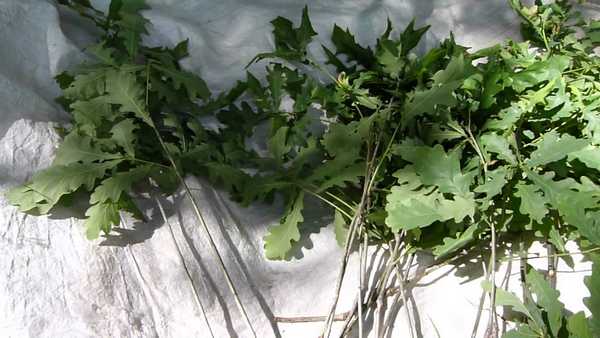
Chopped oak branches should lie a little in the shade
The preparation of oak brooms has its own specifics:
- firstly, the cut branches are stored in a shady place for an hour and a half, and only then can they be transported;
- secondly, after the oak broom is tied, you need to put pressure on it to give it the shape of a fan - this shape is the most common, but some people prefer oak brooms of the traditional spherical shape.
When to cut linden brooms
If you want a linden broom with color, you have a week and a half to prepare it. And that’s due to different species blooming at different times. In general, the best period is considered to be when most of the flowers have already opened. The aroma in the bathhouse is amazing.
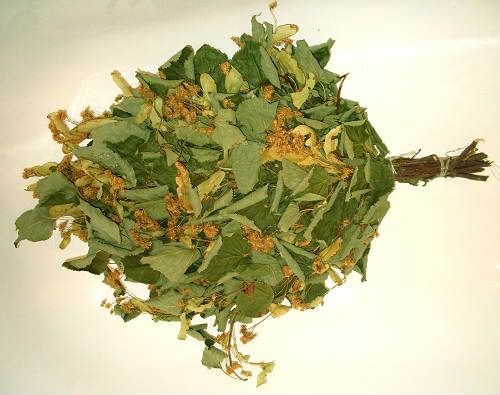
Linden with flowers smells amazing, but they won’t be able to “work” properly - the leaf is soft
There is a linden broom and a later preparation. He also has a period of two weeks - from August 15 to September 1. This is what experts say, who claim that previously collected linden branches contain, of course, more useful substances, but the leaf on them is too soft and, when steamed, curls and wrinkles so that it is absolutely impossible to steam with it.
Preparation of coniferous brooms: spruce, juniper
The “widest collection range” is found in coniferous species. There are no restrictions here. In Siberia, coniferous brooms are made both in the most severe frosts and in the summer...
Choose a warm, fine, dry day for harvesting. The branches begin to be cut after the dew has dried. They choose the young and flexible. There are no other recommendations.
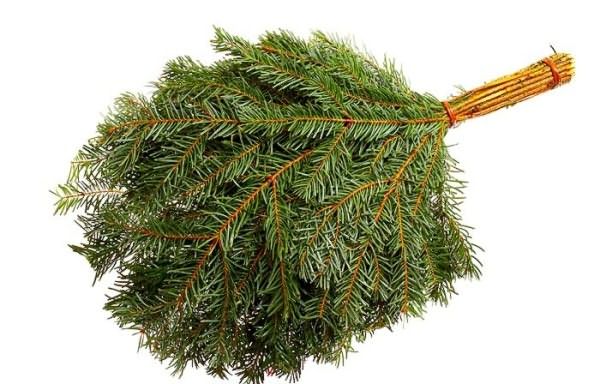
It looks scary, but they say that with proper processing it is tolerated even by delicate skin
